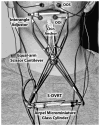Modification of perioral stiffness in patients with repaired cleft lip and palate
- PMID: 21247345
- PMCID: PMC3681518
- DOI: 10.1597/10-092
Modification of perioral stiffness in patients with repaired cleft lip and palate
Abstract
Objective: To measure and compare the perioral stiffness among three groups of pediatric subjects: a group of patients with a repaired cleft lip (and palate) who had a secondary lip revision surgery (revision), another group of patients with repaired cleft lip (and palate) who did not have secondary surgery (nonrevision), and a group of noncleft "normal" patients (noncleft).
Design: A parallel, three-group, nonrandomized clinical trial.
Participants: A total of 16 patients with repaired cleft lip/palate who did not have lip revision, 13 patients with repaired cleft lip/palate who had lip revision surgery and were tested at 18 to 24 months postsurgery, and 27 noncleft patients.
Analysis: Nonparticipatory perioral stiffness was sampled using a recently developed face-referenced measurement technology known as OroSTIFF. Perioral stiffness, derived as a quotient from resultant force and interangle lip span, was modeled with multilevel regression techniques. Real-time calculation of the perioral stiffness function demonstrated a significant quadratic relation between imposed interangle stretch and resultant force for each of the three groups.
Results: This nonlinear stiffness growth function was significantly elevated in the nonrevision patients compared with the noncleft controls and is likely due to the presence of scar tissue in the upper lip; it was significantly lower among patients with cleft lip/palate who completed lip revision surgery.
Conclusion: This study demonstrates the efficacy of applying an objective measurement to map differences in perioral tissue biomechanics among patients born with orofacial clefts.
Figures
Similar articles
-
OroSTIFF: Face-referenced measurement of perioral stiffness in health and disease.J Biomech. 2010 May 28;43(8):1476-82. doi: 10.1016/j.jbiomech.2010.01.037. Epub 2010 Feb 24. J Biomech. 2010. PMID: 20185131 Free PMC article.
-
Nonparticipatory stiffness in the male perioral complex.J Speech Lang Hear Res. 2009 Oct;52(5):1353-9. doi: 10.1044/1092-4388(2009/08-0101). Epub 2009 Aug 28. J Speech Lang Hear Res. 2009. PMID: 19717655 Free PMC article.
-
Quantitative evaluation of the shape and the elasticity of repaired cleft lip.Cleft Palate Craniofac J. 1993 May;30(3):309-12. doi: 10.1597/1545-1569_1993_030_0309_qeotsa_2.3.co_2. Cleft Palate Craniofac J. 1993. PMID: 8338861
-
Soft tissue response to orthognathic surgery in persons with unilateral cleft lip and palate.Cleft Palate Craniofac J. 1993 May;30(3):320-7. doi: 10.1597/1545-1569_1993_030_0320_strtos_2.3.co_2. Cleft Palate Craniofac J. 1993. PMID: 8338863 Review.
-
Anaesthesia for cleft lip and palate surgery.BJA Educ. 2021 Oct;21(10):384-389. doi: 10.1016/j.bjae.2021.06.002. Epub 2021 Aug 25. BJA Educ. 2021. PMID: 34567793 Free PMC article. Review. No abstract available.
Cited by
-
Facial Expressions of Emotion in Children with Cleft Lip and Palate.Cleft Palate Craniofac J. 2024 Aug 28:10556656241271650. doi: 10.1177/10556656241271650. Online ahead of print. Cleft Palate Craniofac J. 2024. PMID: 39193752
-
Dental Decay Phenotype in Nonsyndromic Orofacial Clefting.J Dent Res. 2017 Sep;96(10):1106-1114. doi: 10.1177/0022034517709961. Epub 2017 May 23. J Dent Res. 2017. PMID: 28535364 Free PMC article.
-
Face-referenced measurement of perioral stiffness and speech kinematics in Parkinson's disease.J Speech Lang Hear Res. 2015 Apr;58(2):201-12. doi: 10.1044/2015_JSLHR-S-13-0293. J Speech Lang Hear Res. 2015. PMID: 25629806 Free PMC article.
-
Impairment in facial expression generation in patients with repaired unilateral cleft lip: Effects of the physical properties of facial soft tissues.PLoS One. 2021 Apr 22;16(4):e0249961. doi: 10.1371/journal.pone.0249961. eCollection 2021. PLoS One. 2021. PMID: 33886591 Free PMC article.
-
A comparison of orofacial profiles in 5- and 10-year-old Swedish children with and without cleft lip and/or palate.Clin Oral Investig. 2019 Mar;23(3):1341-1347. doi: 10.1007/s00784-018-2562-3. Epub 2018 Jul 16. Clin Oral Investig. 2019. PMID: 30014165
References
-
- Barlow SM, Abbs JH. Fine force and position control of select orofacial structures in the upper motor neuron syndrome. Exp Neurol. 1986;94:699–713. - PubMed
-
- Barlow SM, Burton M. Ramp-and-hold force control in the upper and lower lips: developing new neuromotor assessment applications in traumatically brain injured adults. J Speech Lang Hear Res. 1990;33:660–675. - PubMed
-
- Barlow SM, Iacono RP, Paseman LA, Biswas A, D’Antonio LD. The effects of experimental posteroventral pallidotomy on force and speech aerodynamics in Parkinson’s disease. In: Cannito MP, Yorkston KM, Beukelman DR, editors. Speech Motor Control. Baltimore: Paul H. Brookes; 1998. pp. 117–156.
-
- Barlow SM, Müller EM. The relation between interangle span and in vivo resultant force in the perioral musculature. J Speech Lang Hear Res. 1991;34:252–259. - PubMed
-
- Barlow SM, Rath EM. Maximum voluntary closing forces in the upper and lower lips of humans. J Speech Lang Hear Res. 1985;28:373–376. - PubMed
Publication types
MeSH terms
Grants and funding
LinkOut - more resources
Full Text Sources
Medical



